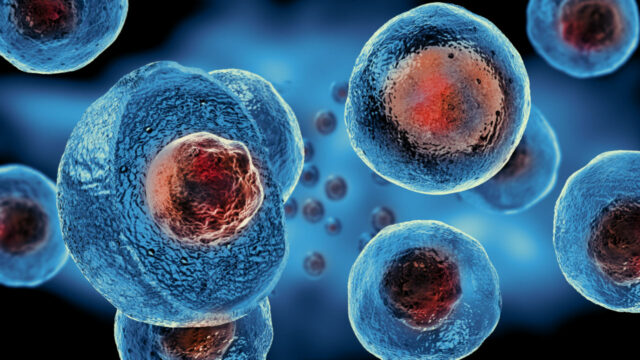
Xintela lyfter XSTEMs unika egenskaper
Biomedicinbolaget Xintela utvecklar stamcellsprodukter med terapeutiska egenskaper som syftar till att behandla sjukdomar som idag saknar effektiva behandlingsalternativ. Bolagets stamceller särskiljer sig genom ett selektionssteg i produktionsprocessen som ger kvalitetssäkra, homogena och rena stamcellspreparationer. Lucienne Vonk, Director Musculoskeletal Diseases på Xintela, berättar för BioStock om fördelarna med bolagets stamcellsprodukter.
Biomedicinbolaget Xintela utvecklar stamcellsprodukterna XSTEM, för behandling av artros och svårläkta bensår hos människor, och EQSTEM för behandling av ledsjukdomar hos hästar.
Bolagets forskning och utveckling baseras på stamcellsmarkören integrin α10β1 som upptäcktes på 90-talet av Xintelas vd Evy Lundgren-Åkerlund och hennes forskargrupp vid Lunds universitet.
Mesenkymala stamceller med terapeutiska egenskaper
Xintelas stamcellsprodukter består av mesenkymala stamceller (MSC) som är en typ av multipotenta celler som har förmågan att omvandlas till olika celltyper, inklusive broskceller.
Stamcellerna kan återskapa och regenerera skadade vävnader och organ, och stimulera celler i en skadad vävnad att reparera skadan. MSC kan också signalera immunceller och ge upphov till en antiinflammatorisk effekt.
Stamceller från vuxna donatorer
Xintelas stamcellsbaserade behandlingar består av donerade (allogena) stamceller från fettväv från friska vuxna donatorer. Stamceller från en donator kan användas för behandling av många patienter, vilket är mer kostnadseffektivt än att använda patientens egna stamceller.
Rena stamcellspreparationer genom selektering
Dock är stamcellspreparationer från vävnader ofta heterogena, vilket betyder att de är kontaminerade med andra celltyper. Dessutom kan stamcellspreparationerna skilja sig från donator till donator. Detta kan skapa problem både regulatoriskt och funktionellt.
Xintelas lösning är att rena stamceller med hjälp av en antikropp som binder bolagets stamcellsmarkör, integrin α10β1. Selektionen gör att Xintela erhåller rena och homogena stamcellspreparationer av hög kvalitet som är reproducerbar mellan olika donatorer.
Knäartros och svårläkta bensår i fokus
Xintela genomför två kliniska fas I/IIa-studier med XSTEM; en på patienter med knäartros och en på patienter med svårläkta venösa bensår. Bolaget rekryterar patienter till sårstudien och genomför dosering på tredje och sista dosnivån i artrosstudien. Målet är att presentera säkerhetsdata och preliminära effektdata från båda studierna under 2023.
Artros är en ledsjukdom som är förknippad med nedbrytning av brosket, svår smärta och försämrad rörlighet. Standardbehandling handlar oftast om att lindra symptomen och som sista alternativ att ersätta den degenererade artrosleden med en protes.
Xintela förväntar sig att stamcellsprodukt XSTEM kommer att leda till minskad smärta och förbättrad ledfunktion. Tidigare resultat från bolagets prekliniska studier tyder även på att XSTEM är en sjukdomsmodifierande behandling som kan regenerera skadat ledbrosk. Läs mer.
Xintelas Director Musculoskeletal Diseases kommenterar

BioStock kontaktade Lucienne Vonk, Director Musculoskeletal Diseases på Xintela, för att få veta mer om fördelarna med Xintelas stamcellsteknologi och hur konkurrensen inom området ser ut.
First, could you give us a more detailed explanation of how Xintela’s selection of stem cells is conducted?
– For the selection of the stem cells, we use magnetic beads that are coated with an antibody that binds the company’s stem cell marker, integrin α10β1. The stem cells have integrin α10β1, like a flag, on their cell surface. The magnetic beads will bind to these flags and then, by using a magnet, we can select the stem cells from other cells that do not have the marker on the surface and are thus washed away. After this step, the selected homogenous stem cells population is further expanded in bioreactors to generate the stem cell product XSTEM.
What are the main benefits of the selection technology?
– The main benefit is that the selection generates a homogenous and high-quality stem cell product that can meet the regulatory requirements of identity, purity and potency and that is very consistent between different donors.
– A stem cell preparation without stem cell selection is heterogenous and contains more or less contaminating cells, such as epithelial cells, endothelial cells and fibroblasts. These contaminating cells can have a negative impact on the safety and the therapeutic effects of the stem cell preparation. In addition, since the number of contaminating cells varies between each preparation, it is difficult to give the product a clear identity and to control the therapeutical effect.
– With our selection technology, we can control the stem cell preparations and ensure quality and therapeutic effect of the products. In addition to our selection technology, we also manufacture our cell product in our own GMP-certified facility. Together, these allow us to maintain full control over both the production process and the final cell product.
»With our selection technology, we can control the stem cell preparations and ensure quality and therapeutic effect of the products. In addition to our selection technology, we also manufacture our cell product in our own GMP-certified facility. Together, these allow us to maintain full control over both the production process and the final cell product.«
Why are you using donor (allogeneic) stem cells instead of autologous and/or genetically modified stem cells?
– There are several advantages of using allogeneic instead of autologous stem cells. First of all, it is only possible to offer a true single-stage, off-the-shelf, stem cell therapy with allogeneic cells. For autologous stem cells, patients first need to undergo a primary procedure to harvest tissue (such as adipose or bone marrow) from which the stem cells can be isolated, and culture expanded. Using allogeneic cells also omits a procedure at another (not the affected) location in the body, that could lead to damage at the harvest location such as an infection (donor site morbidity).
– Furthermore, since allogenic stem cells, like XSTEM, can be stored in the freezer in the clinic the patients can be directly treated and start their rehabilitation without going through the procedure to collect the autologous tissue and culture of the cells. Another advantage of using allogeneic cells is the reduced treatment cost per patient as several thousands of patients can be treated with stem cells from one donor. In addition, donors and cells with the highest quality and therapeutic effects can be selected.
»Furthermore, since allogenic stem cells, like XSTEM, can be stored in the freezer in the clinic the patients can be directly treated and start their rehabilitation without going through the procedure to collect the autologous tissue and culture of the cells. Another advantage of using allogeneic cells is the reduced treatment cost per patient as several thousands of patients can be treated with stem cells from one donor.«
– The advantages of allogeneic mesenchymal stem cells over genetically modified stem cells are that the risk of genetic instability is very low as clinically relevant numbers of cells can be reached with a relatively short cell culture expansion, while genetically modified stem cells are usually exhaustively expanded. Further, allogeneic tissue derived stem cells can also home to the site of damage and differentiate into several cell types and act immunomodulatory and anti-inflammatory. So, they have the potential to treat a wide range of diseases without the need for pre-differentiation, while genetically modified stem cells need to be fully differentiated before administration into the body, as they can otherwise form teratoma (tumors that contain different types of tissue).
– So far, tissue derived mesenchymal stem cells such as stem cells from adipose tissue, are the most used type of stem cell in clinical studies and therefore they are already extensively tested for safety.
Are other stem cell companies using a similar technology as Xintela?
– There are several companies working on allogeneic stem cell-based treatments for osteoarthritis. For example Stempeucel (Stempeutics, India) is undergoing phase III studies, CYP-004 (Cynata, Australia) which is in phase III studies, AlloJoin (CBMG, China) which is in phase II and Progenza (Regeneus, Australia) which is in phase II. Furthermore, Cartistem, which is developed by Medipost, has market approval in South Korea. However, none of these companies use a cell-selection in their production process.
There are already clinics that use mesenchymal stem cells from adipose tissue for the treatment of osteoarthritis. In what way is Xintela’s stem cell treatment different to these?
– There are clinics that use minimally manipulated tissue products, but those are not mesenchymal stem cell products. The minimally manipulated tissues are for instance bone marrow, concentrated bone marrow, or the stromal vascular fraction of adipose tissue. Only a very small percentage of the cells in these products are mesenchymal stem cells (0.001% to 0.01% in bone marrow and bone marrow concentrate, 1% to 4% in the stromal vascular fraction of adipose tissue). Thus these products should not be called “stem cells”. Especially in the USA, the Food and Drug Administration (FDA) is very strict with this terminology.
»There are clinics that use minimally manipulated tissue products, but those are not mesenchymal stem cell products. The minimally manipulated tissues are for instance bone marrow, concentrated bone marrow, or the stromal vascular fraction of adipose tissue. Only a very small percentage of the cells in these products are mesenchymal stem cells«
– Also, these minimally manipulated tissue products are less strictly regulated, but only if they are intended for homologous use, meaning to perform the same basic function as they did before administration. These products are not considered drug products and therefore no safety and efficacy studies or quality tests are required, they cannot be marketed and sold as medicinal product, and thus they are usually not covered by healthcare insurance. Xintela´s stem cell products are regulated as advanced therapy medicinal product (ATMP). ATMPs are required to possess proven safety and efficacy, each product is quality tested and they can be covered by healthcare insurance and thereby become available for everybody.
Innehållet i BioStocks nyheter och analyser är oberoende men BioStocks verksamhet är i viss mån finansierad av bolag i branschen. Detta inlägg avser ett bolag som BioStock erhållit finansiering från.


